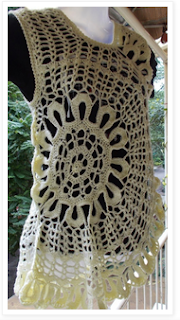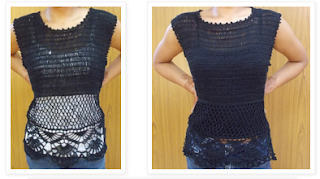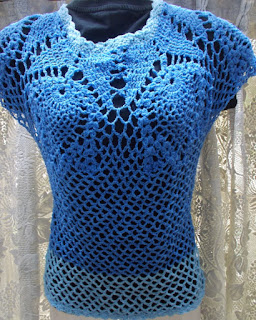EASY ONE PIECE SHELLED BOLERO
Yet
another pattern that I just could not resist and of course seems like you agree
too, as here we are .. you and I are back working on this together. So while this is not a 'true' total one-piece bolero, it's a neat one piece construction for the bottom part.. and I loved how that worked out.
Thank you for joining me.
In case you have just joined me, know that you can access all of my earlier creations by checking under ‘categories’ on the right hand side of this blog under “Labels”. Then, for your convenience, follow me here or on Facebook, You Tube, Pinterest, Twitter or Instagram.
Check out all my social media handles at the bottom of this blog
Oh, and may I add that the fastest way to find any of my blogs is via Pinterest.
All my blogs can be printed. Find the printer friendly (green) link on the right side of this blog. You can also hit Control P (or Command P for Mac) on your keyboard, and the blog will go directly to the connected printer.
Remember that you only print if absolutely essential. Save paper – Save Our Earth.
Do remember to add my blog URL when you make and show off your creation.
Just copy the link on the search bar above - that's the blog URL.
To purchase this or similar yarn online, click here to buy your yarns online via Amazon. While you will still pay the same, I may get paid by Amazon as well.
This is a free blog - so do pay it forward for me. Cheers.
Materials used : Today
I’ve used our superb Indian Modi knitting cotton yarn, with a 3 mm crochet hook.
This yarn is not specific for this pattern. Use any yarn with a suitable hook to make this to any size.
For Non-Indians : I have used a regular knitting cotton that technically uses a 2 – 2.5 mm crochet hook (recommended). I use a larger hook as I like the extra stretch it affords the end product. Among the international yarns I have used in this thickness, I’d suggest Aunt Lydia Cotton 10, Aunt Lydia Bamboo-Viscose 10, DMC Petra, Sullivans knitting cotton (Australia), Milford Soft, Hilaza Rustica Eclat , Alize cotton yarn and Alize bamboo yarn.
Skill level :
Intermediate
Abbreviations used : (Using U.S terminology)
ch : chain ch-sp
: chain space
sp : space rep
: Repeat
st(s) : Stitch(es) hk : Hook
sl-st : Slip stitch
yo : yarn over lp(s) : Loop(s)
fsc : Foundation single crochet
dc : Double crochet
Stitches used :
Instructions : (Using U.S terminology)
Please note that I start all my rows with a ch 1, turning chain for ease.
Please check the top of this blog for easy video tutorials on all stitches used in today's pattern. For your convenience there video tutorials through the blog too
Please read through all my notes before you pick up your hook, so you know just where we're heading in our pattern.
In my patterns I work with the principle of stitch count and body measurement. This means that you need to work the stitch count in pattern, till you get the measurement (length and/or width) that you need for your project.
This is not my original pattern. I found this photograph and a convenient chart on the internet.
As I work on this pattern, I’ve written down my notes that I share with you.
Quick analysis of what we’re going to do here
today.
We work
our vest in two pieces.
One piece is
worked from the armhole down and the other part is worked armhole to shoulders.
The unusual construction of this vest is what seems challenging and fun
here.
So for this vest, we will work the
lower half in one piece, starting with one front end of the vest, working
through the back and then to the other front end of the vest. This part is
worked in pattern, as a rectangular piece, and we will then work the top part
of the vest on top of this bit.
Seem simple enough – so let’s
get started.
Now this rectangular piece is
worked depending on the (vertical) length you want for your vest from the
armhole down to the length intended for your vest.
PART 1 :
Start with fsc in multiples of 6 + 1 (length needed from armhole to
end of vest).
Double Crochet : dc : yo, insert hk into st ; yo (3 lps on hk);
[yo, draw through 2 lps] twice. One dc made.
Chainless start for Double Crochet : I dislike the ch-2 / ch – 3 start, and this is what I do to start my row of dc.
Double crochet 2-tog : dc 2-tog : [yo, insert hk in st or ch-sp, yo and pull up a lp ; yo and draw through 2 lps] 2 times (3 lps on hk) ;
{yo, draw through 2 lps on hk} 2 times. One dc 2-tog made.
Sometimes we work the dc 2-tog in the same stitch, to use as a decorative stitch.
Row 1 : dc in the 1st fsc ;
*(ch 2, sk next 2 fsc , dc 2-tog in the next fsc) ;
[ch
2, sk next 2 fsc , dc in the next fsc] ;
ch 5, sk next 5 fsc, dc in the next fsc* ;
rep *to* till end. Turn.
Row 2 : dc in the 1st dc ;
*(ch 2, dc 2-tog in the next
ch-5 sp ;
ch 2, dc in the next dc) ;
[ch 5, sk next dc 2-tog, dc in the next
dc]* ;
rep *to* till end. Turn.
Row 3 : dc in the 1st dc ;
*(ch 2, dc 2-tog in the next
ch-5 sp ;
ch 2, dc in the next dc) ;
[ch 5, sk next dc 2-tog, dc in the next
dc]* ;
rep *to* till end. Turn.
Once you’ve reached the width
(or round waist / bust) measure you need for your rectangle, finish off with a
row of dc.
Ensure before you finish that
your last row is the same pattern as the first row.
Last row : sc in the 1st
dc ;
(dc in each ch ; dc in each dc 2-tog) all the way to the end. Turn.
So for the yoke of our top, we
will be working along one of the sides of the rectangle just made, and we will work
the same pattern upwards to the shoulders / neck.
The pattern will *look* different as now the
dc 2-tog will be facing a different direction and that is what gives this
pattern the unusual look.
Now what we need to do is mark
the two sides for our vest.
Fold the rectangle that you’ve
made in such a way that the two open sides come together in front, and you can
then mark the two points for the sides / armholes.
We should we skip one pattern
repeat on either side of our folded rectangle, and place a marker (or four
markers) that will denote the points for the sides we will be working with.
The back is worked in a
rectangle, with no decrease on either armhole or shoulder / back of neck.
There
is a neat decrease for both sides of the front to give a neat “V”-shaped
neckline.
For convenience, I am
re-numbering this section, so please do not confuse these instructions with
those that have come before.
We are at one corner of the
rectangle.
We will turn our work and
start working along the length of our rectangle (the longer portion of it) for
the first row of our yoke.
In this first foundation row of
the yoke, we will be working along the horizontal bars of the stitches made,
and the spaces between two horizontal bars.
PART 2 :
Our stitch count still stands
at 6 + 1, so ensure that you have this count at the end of the foundation row.
Foundation row : sc in the 1st
st ;
(2 sc in the horizontal bar of the next dc ;
sc in the st between 2
horizontal bars ;
2 sc in the next dc 2-tog horizontal bar ;
sc in the st
between 2 horizontal bars) ;
rep (to) all the way to the end. Turn.
We will now work one side of
our Front Yoke till the first marker placed.
Please note that the pattern repeat *to* may not work for all of us as
per the written instructions, mainly because we will be dividing differently
for the armhole etc. However, as you
have done this pattern repeat several times already, you know it , and need to
ensure that you work the repeats in a way that suits you best.
The instructions below are for reference
only.
Row 1 : dc in the 1st sc ;
*(ch 2, sk next 2 sc , dc 2-tog in the next sc) ;
[ch 2,
sk next 2 sc , dc in the next sc] ;
ch
5, sk next 5 sc, dc in the next sc* ;
rep *to* till marker . Turn.
Row 2 : dc in the 1stdc ;
*(ch 2, dc 2-tog in the next
ch-5 sp ;
ch 2, dc in the next dc) ;
[ch 5, sk next dc 2-tog, dc in the next
dc]* ;
rep *to* till end. Turn.
Row 3 : dc in the 1st dc ;
*(ch 2, dc 2-tog in the next
ch-5 sp ;
ch 2, dc in the next dc) ;
[ch 5, sk next dc 2-tog, dc in the next
dc]* ;
rep *to* till end. Turn.
Yet again our pattern repeat
will be Rows 2 and 3.
So calculations : Decide how deep you want the neckline, and work only till
that point, ensuring that you end at the front lapel (open) portion of your
vest for the first decrease.
As mentioned before, the
decreases are only along the neckline border.
Both front and back armhole(s) will be worked straight, without
decrease.
With each decrease on the open
lapel side, we will work till halfway down the first pattern bit.
Now we have two pattern bits.. one is a ch-5
sp and one is a (ch-2, dc 2-tog, ch-2) set.
The centres of these sets will be the dc 2-tog and centre of the ch-5
sp.
What we’re attempting to do is
to get a neat gradual “V”-shaped neckline ensuring that you only decrease till
you get the shoulder width needed.
To get an even “V” shape, we
will decrease these 3 sts every row.
So yet again, these
instructions are only for reference.
I’d suggest that you work out your shoulder width from the end of the
armhole, place a marker, and then work the “V”-shape for your neck.
Decrease Row 1 : skipping the 1st dc , sl-st all the way to the
centre of the ch-5 sp or the dc 2-tog ; ch 2, dc in the next dc ;
*(ch 2, dc
2-tog in the next ch-5 sp ;
ch 2, dc in the next dc) ;
[ch 5, sk next dc 2-tog,
dc in the next dc]* ;
rep *to* till end.
Turn.
Decrease Row 2 : dc in the 1st dc ;
*(ch 2, dc 2-tog in the next
ch-5 sp ; ch 2, dc in the next dc) ;
[ch 5, sk next dc 2-tog, dc in the next
dc]* ;
rep *to* till dc before end ;
dc in that last dc. Turn.
Rep Decrease Rows 1 & 2
till you reach the shoulder.
Fasten off and leave a tail to
attach shoulder.
Re-attach yarn at the other
front lapel end, and mirror these instructions for the other front.
For the back, we will re-attach
the yarn at the marker for the back, and work the pattern without decrease
between the two markers for the back.
Once you’ve completed both
front halves as well as the back, attach the shoulders.
We will now work the cute
little sleeve bit.
PART 3 : Sleeve :
These are little cap-like sleeves that are basically for the top bit of the arm.
However as this is a general write up, here’s
what I’d suggest.
The pattern is a
simple repeat that we’ve worked through the whole top, so you know that.. start
with the pattern as per the instructions below, pop it onto your arm / vest and
see how it works out – else add (pattern repeat) stitches on either side to
make up the length/width desired.
For the sleeve, we will start
from the bottom of the sleeve and work our way up to the armhole, decreasing
both sides to give it the easy curve needed.
I am writing the pattern out as
charted.
Start with 97 fsc (Our stitch count is 6 + 1 , and I got 16 pattern repeats with 97 fsc)
From our very first row, we
start with decreases to get the curved shape for the arm.
As we’re reducing both ends,
one end will need a 5 st finish, which is our dtr (double treble).
Double Treble /Triple Crochet : dtrc : wrap yarn three times around hook, insert hk into st ; yo (4 lps on hk); [yo, draw through 2 lps] three times. One trc made.
The other way to do this is to do 5 ch and a sc
in the last st, and then you sl-st through that last set of 5-ch to come to the
1st dc 2-tog for the next decrease and curved edging.
So choose whichever suits you, but I’m writing
it with the dtr finish.
Row 1 : sc in the 1st fsc ;
ch 5, sk next 5 fsc, dc
2-tog in the next fsc ;
(ch 5, sk next 5
fsc , dc 2-tog in the next fsc) ;
rep (to) till last 6 fsc ;
sk next 5 fsc, dtr
in the last fsc. Turn.
Row 2 : sc in the 1st dc 2-tog ;
(ch 5, dc 2-tog in the
next dc 2-tog) ;
rep (to) till last the 2nd last dc 2-tog ;
dtr in
the last dc 2-tog. Turn.
Rep Row 2 till you have about 5
dc 2-tog on the last row, which will be the top of the armhole.
You now have a neatly curved
sleeve.
The last row will be the top
and the foundation row is the part that goes around the arm.
Fasten off.
To attach the sleeves on, I’d
suggest that you first fold the sleeve and mark the centre point. Pin this
centre point to the shoulder line, and then neatly pin the curved portion of
the sleeve along the sides of the armhole till the sides of your top.
Once pinned down, attach the
sleeve to the top, and we’re done with it.
PART 4 : Border :
For the border, we will go back
to that foundation fsc row and we will work one continuous round from one side
of the front, across the back down the other side of the front. We will also do the similar border along the
armhole.
Just for convenience, I suggest you run a round of sc all around the front and back of your garment.
Border Row : sc in the 1st
st ;
*ch 2, sk next 2 sts, dc 2-tog in the next st ; ch 2, sk next 2 sts, sc in
the next st* ;
rep *to* all around ; join with a sl-st to the 1st
st.
Fasten off and weave in ends.
Give yourself a big pat on the
back as this one has really been a great project – but totally worth it, I’m
sure you’ll agree.
And that’s done.. yet another
project brilliantly executed !
Enjoyed this ?? I sure did.. Come back right here for more freebie patterns
Remember to share this blog post when you share your photos with me on Facebook. I’d love to feature your photos on my FB page. Cheers.
If you're visiting me here for the first time, and have liked the experience, do add me to your mailing list (for your convenience) , and all my future free patterns will come straight to your mail box.
I’d appreciate if you could credit my blog (and link the original pattern link) when you make your own creation. Thanks.
Have a great day and see you soon.
I have a few tops already
made, and just
in case you want a dekho at those free patterns … here you go
and a doll’s top..
and some bolero/jacket/vests that will look grand on a top..
I have a few girls dresses, and just in case you want a dekho at those free patterns … here you go
For cute hair embellishments and motifs check the links below.
..and some belts..
and here are a few skirt patterns that you can use your belt for..




































No comments:
Post a Comment
Thanks for taking the time to stop by. Do tell me what you think. Cheers